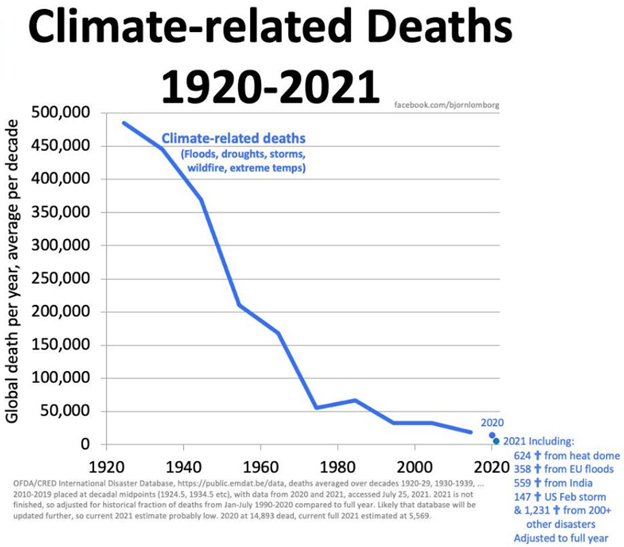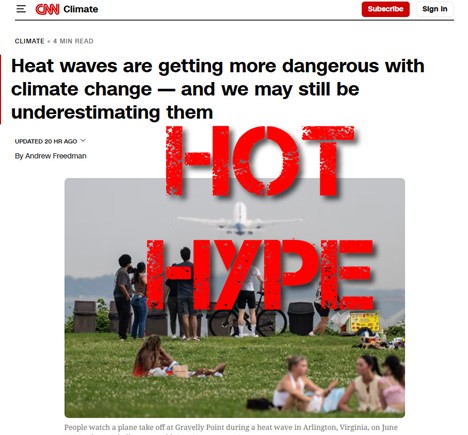In the article “Heat waves are getting more dangerous with climate change — and we may still be underestimating them,” CNN boldly claims that human-induced climate change is making heatwaves “more common, intense and longer-lasting,” and that we are likely underestimating the risk. This is false, refuted by actual long-term temperature records. The available evidence clearly suggests that while urban areas do experience warmer nights due to the well-documented Urban Heat Island (UHI) effect, there is no global trend of increasing heat wave frequency or intensity after accounting for urbanization, data quality, and the selective reporting that plagues much of the mainstream climate narrative.
CNN does briefly acknowledge that overnight temperatures are increasing in towns and cities, pointing to the UHI effect as a culprit. However, they conveniently skip over the larger implication: these localized temperature increases are not evidence of a trend attributable to climate change. They are a function of sprawling urban development, asphalt, concrete, and waste heat from human activity, not a signal of global warming, much less a planetary crisis. Studies show that rural temperature stations, far from the heat-retaining concrete jungles, do not show the same rate of warming as urban stations.
Climate at a Glance: U.S. Heatwaves presents historical data from the National Oceanic and Atmospheric Administration (NOAA) which show that heat waves were far more severe in the 1930s than they are today. The number of days exceeding 95°F in the 1930s dwarfs anything seen in recent decades, as seen in Figure 1 below.

Both the intensity and frequency of heat waves were much worse nearly a century ago. CNN chooses to ignore this broader historical context.
In addition, multiple articles on Climate Realism demonstrate that the mainstream media loves to focus on short-term spikes and isolated events while completely disregarding the cooling trends and the full historical record. One article, “CNN Ignores Long-Term Data, Claims Heat Waves Are Becoming More Severe,” shows how CNN conveniently glosses over the U.S. Environmental Protection Agency’s data which contradict their claims, by showing that heat waves were far more prevalent and severe during the 1930s and the 1950s, for example.
CNN’s article leans heavily on attribution studies, particularly those from the World Weather Attribution (WWA) project, which claim that today’s heat waves are made “tens to hundreds of times more likely” by climate change. These studies are based on climate model simulations, not observed temperature data or trends. The issue with attribution models, as thoroughly discussed at Watts Up With That, is that they often start with the assumption that most warming is due to human activity and then “discover” that warming in their results. It’s a classic case of confirmation bias wrapped in scientific jargon. In logic this is referred to as a logical fallacy, in particular, affirming the consequent.
Climate Realism has repeatedly debunked previous attribution “studies,” produced by WWA in the past, here, here, and here, for example.
To support its assertions about worsening heatwaves, CNN sought out the opinions from noted long-time promoters of climate alarm, Friederike Otto and Michael Mann. Otto, who is the director of WWA, told CNN that “every heatwave that is occurring today is hotter than it would have been without human-induced climate change.” What else would Otto say? After all she runs the organization making the extraordinary heat wave claims, claims not supported by real-world data. Her sweeping statement is not grounded in hard observational data but rather in models that have a known tendency to run hot, consistently projecting more warming than actually observed. The fact that these models can’t even accurately predict regional temperatures or temperature trends, much less individual heat waves, is conveniently omitted from CNN’s coverage.
Mann, warned CNN that “climate models are likely understating the relationship between climate change and persistent summer weather extremes today and under predicting the potential for future increases in such extremes.” So for Mann, flawed models that project more warming than is actually occurring are understating heat wave occurrences and severity. Yet increasing trends of either can’t be found in the data. If anything, the observed evidence suggests that the impact of human greenhouse gas emissions on heat waves is overstated by the climate models WWA uses, not understated.
Even the sensationalized claims about European heat waves fall apart under scrutiny. As pointed out by Climate Realism, these events are well within the range of natural variability. When past temperature records are carefully reviewed, we find that similar or even more extreme heat events occurred long before industrial CO₂ emissions began to rise substantially.
Moreover, CNN recycles the tired trope that heat waves are becoming more “deadly.” Yet, global data consistently show that climate and temperature related deaths have plummeted over the last century, even as the population has quadrupled. Bjorn Lomborg has repeatedly illustrated, using data from the International Disaster Database, that deaths from weather-related events—including heat—are down by over 95% since the 1920s, thanks largely to better infrastructure, forecasting, and adaptation. See Figure 2.

CNN often relies on “rapid attribution studies,” as it does almost exclusively in this piece, yet such studies are not real studies in the traditional sense, nor are they peer-reviewed in the traditional sense. Attribution studies are rushed out in rapid fashion in the hours or days following an event, to push the narrative that climate change is responsible for a particular incident. They are not careful analyses, examining whether climate change played a role in the event. The latter type of study takes time and detailed research, not the click of a button on a computer with the built-in assumption that climate change contributed to an event with the only question being how much. Attribution “science,” is not science at all as it is currently constituted, rather it is a tool designed to reinforce a narrative, not to objectively investigate the cause of weather events.
Recent heat events pale in comparison to the extended heat waves experienced during the “dust bowl” decade of the 1930s and extended heat waves in 1950s. The cherry-picked comparisons CNN uses actively distort the public’s understanding of climate and weather history.
This isn’t the first time CNN has played fast and loose with climate data. They’ve been called out before, including on Watts Up With That, for exactly this type of fear-driven reporting that ignores long-term records in favor of flashy headlines. CNN’s persistent misrepresentation of climate data suggests that accuracy is less important to them than sensationalism. Perhaps that’s because fear sells, but it certainly doesn’t inform.
Ultimately, CNN’s reporting here is a disservice to public understanding. Their reliance on shaky models, their neglect of historical context, and their failure to address the well-known Urban Heat Island effect all point to an agenda-driven narrative rather than serious journalism. If CNN truly cared about informing their audience, they would have corrected these errors by now. Instead, they keep peddling the same fearmongering stories, perhaps because admitting otherwise would undercut the very crisis they’ve worked so hard to sell.
The post Wrong, CNN, Heatwaves Aren’t Becoming More Frequent or Severe appeared first on ClimateRealism.
Click this link for the original source of this article.
Author: Anthony Watts
This content is courtesy of, and owned and copyrighted by, https://climaterealism.com and its author. This content is made available by use of the public RSS feed offered by the host site and is used for educational purposes only. If you are the author or represent the host site and would like this content removed now and in the future, please contact USSANews.com using the email address in the Contact page found in the website menu.








